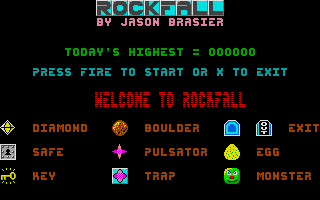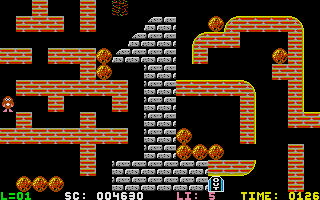Retro Replay Review
Gameplay
Rockfall brings a fresh twist to the classic Boulder Dash formula by delivering tight, time-driven puzzles across 48 handcrafted levels. Each stage tasks you with collecting every diamond before the timer ticks down to zero, and the pressure mounts as you learn to manipulate boulders with precision. Boulders will remain stable only on flat surfaces, but once dislodged, their descent is unstoppable—you’ll quickly discover that patience and planning are as important as quick reflexes.
(HEY YOU!! We hope you enjoy! We try not to run ads. So basically, this is a very expensive hobby running this site. Please consider joining us for updates, forums, and more. Network w/ us to make some cash or friends while retro gaming, and you can win some free retro games for posting. Okay, carry on 👍)
As you progress, Rockfall ramps up the challenge by introducing monsters and pulsators—each appearing in groups of up to four per level. Monsters wander randomly, forcing you to predict their erratic paths or squash them under falling boulders, while pulsators cling to walls and turn left at every corner. Disposing of these foes requires strategic use of traps and environmental hazards, adding a satisfying layer of depth to what might otherwise become a routine digging exercise.
The time system rewards both speed and caution. You start with 180 seconds on level one, and each subsequent stage adds 120 seconds plus any leftover time from the previous round. This carry-over mechanic creates a delicate balance: push too quickly and you risk triggering falling rocks you can’t outrun; move too slowly and the clock runs out. The result is a pulse-quickening puzzle experience that keeps you glued to the screen and eager to shave precious seconds off your best runs.
Graphics
Rockfall’s visuals embrace the retro aesthetic of the original Boulder Dash, rendered in clean, pixel-perfect 68000 assembler graphics. Each element—from crystalline diamonds to rugged stone walls—is distinct and immediately readable, ensuring you never lose track of key objects when the action heats up. The color palette leans into earthy browns and deep blues, evoking the feeling of subterranean caverns lit only by your headlamp.
Animations are simple but effective: boulders tumble convincingly, monsters shuffle with a weighty gait, and pulsators creep along walls with a mechanical precision that stands out against the organic backdrop. While there aren’t flashy particle effects or dynamic lighting, the minimalist approach keeps the focus squarely on gameplay, and the result feels polished rather than barebones.
Subtle visual cues—like slight rock dust when a boulder lands and flashing diamonds when time is running low—add atmosphere without cluttering the screen. Whether you’re playing on a vintage CRT or a modern LCD display, Rockfall’s graphics hold up, offering a timeless charm that celebrates classic arcade design while still feeling crisp enough for today’s standards.
Story
Rockfall doesn’t boast a sprawling narrative or cinematic cutscenes; its story is told through the thrill of exploration and the steady drip of diamonds into your collection bag. You play as a daring spelunker driven by the promise of untold riches buried deep underground. Each level serves as another chapter in your quest for gem-studded glory and the tagline “collect them all before time runs out” functions as both instruction and lore.
The level progression brings subtle shifts in environment and enemy design, hinting at deeper, more perilous tunnels yet to be uncovered. Encounters with pulsators—enigmatic clockwork creatures—suggest an ancient, hidden machinery at work, though details remain delightfully vague. This light touch keeps the focus on the gameplay while offering just enough intrigue to keep you invested in what lies ahead.
Ultimately, Rockfall’s narrative is a canvas for player imagination. Without heavy storytelling, you become the hero of your own diamond-digging saga, experiencing moments of triumph when you outwit a pulsator or heart-pounding dread when a misplaced boulder seals your fate. It’s a minimalist approach that works beautifully for a puzzle-oriented game, letting each successful run tell its own tale.
Overall Experience
Rockfall stands out as a lovingly crafted homage to Boulder Dash, delivering precisely tuned challenges that reward both quick thinking and meticulous planning. The mix of diamond-collecting, monster disposal, and time management coalesces into a gameplay loop that’s easy to learn yet devilishly hard to master. Each of the 48 levels plays like a puzzle box waiting to be solved, and the satisfaction of clearing a stage with seconds to spare is consistently addictive.
Though it hews close to its inspiration, Rockfall adds its own identity through unique enemy behaviors, a thoughtful carry-over timer mechanic, and the occasional trap-based puzzle that forces you to think two steps ahead. The lack of a heavy narrative or modern graphical flourishes may deter players seeking a story-driven or visually cinematic experience, but for fans of pure, skill-based puzzle action, those very omissions become strengths.
Whether you’re a retro enthusiast, a puzzle veteran, or simply someone who enjoys precision-driven challenges, Rockfall delivers a compelling package. Its 68000 assembler roots shine through in the responsive controls and seamless performance, making every level feel fair yet challenging. If you’re ready to tackle demanding cave networks, outsmart wandering monsters, and race against the clock, Rockfall offers hours of rewarding gameplay that will keep you digging deeper long after you collect your first diamond.
 Retro Replay Retro Replay gaming reviews, news, emulation, geek stuff and more!
Retro Replay Retro Replay gaming reviews, news, emulation, geek stuff and more!








Reviews
There are no reviews yet.